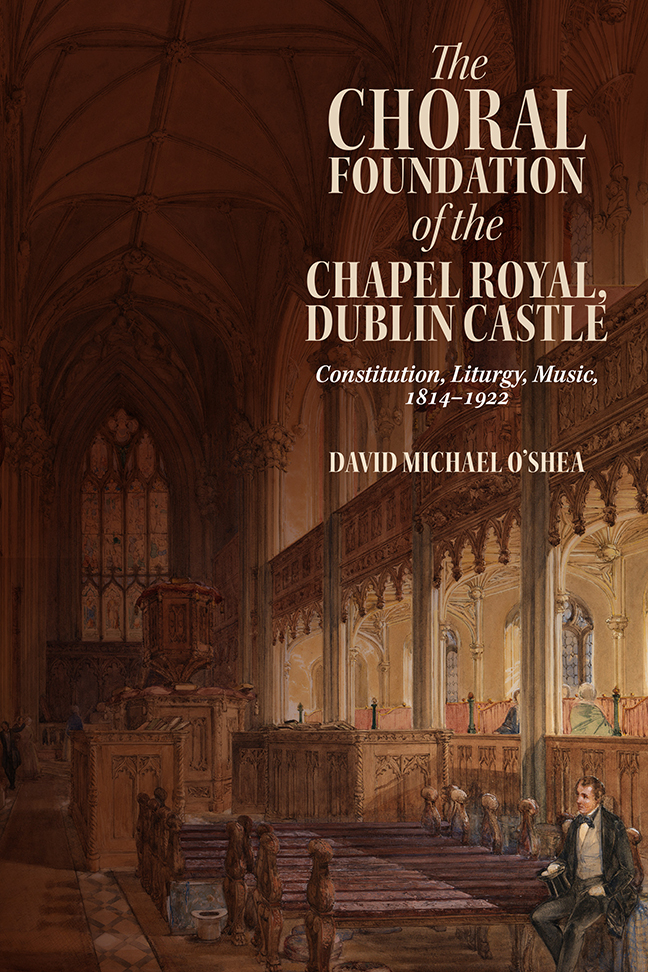Book contents
- Frontmatter
- Contents
- Illustrations
- Foreword
- Preface
- Acknowledgements
- A Note on Terminology
- Abbreviations
- Introduction
- 1 Precedents, Polity and Politics
- 2 Clergy
- 3 Churchmanship, Furnishings and Functions
- 4 The Musical Foundation
- 5 The Chapel Royal Music Collection
- 6 Singing the Liturgy
- 7 Organs
- 8 Boy Choristers
- 9 Gentleman Singers
- 10 Organists and Composers
- 11 The Chapel Royal's Legacy
- Conclusion
- Appendix A Lords Lieutenant, 1801–1922
- Appendix B Clergy of the Chapel Royal
- Appendix C Extant Chapel Royal Music Volumes (RCB MS 1113)
- Appendix D Boy Choristers of the Chapel Royal
- Appendix E Gentlemen Singers of the Chapel Royal
- Appendix F Organists of the Chapel Royal
- Appendix G Fragment of a Juvenile Chant by C. V. Stanford
- Bibliography
- Index
- Irish Musical Studies Previous volumes
1 - Precedents, Polity and Politics
Published online by Cambridge University Press: 10 January 2024
- Frontmatter
- Contents
- Illustrations
- Foreword
- Preface
- Acknowledgements
- A Note on Terminology
- Abbreviations
- Introduction
- 1 Precedents, Polity and Politics
- 2 Clergy
- 3 Churchmanship, Furnishings and Functions
- 4 The Musical Foundation
- 5 The Chapel Royal Music Collection
- 6 Singing the Liturgy
- 7 Organs
- 8 Boy Choristers
- 9 Gentleman Singers
- 10 Organists and Composers
- 11 The Chapel Royal's Legacy
- Conclusion
- Appendix A Lords Lieutenant, 1801–1922
- Appendix B Clergy of the Chapel Royal
- Appendix C Extant Chapel Royal Music Volumes (RCB MS 1113)
- Appendix D Boy Choristers of the Chapel Royal
- Appendix E Gentlemen Singers of the Chapel Royal
- Appendix F Organists of the Chapel Royal
- Appendix G Fragment of a Juvenile Chant by C. V. Stanford
- Bibliography
- Index
- Irish Musical Studies Previous volumes
Summary
Chapels royal
Though the history of Anglican choral composition and practice is often described as the ‘English cathedral tradition’, the cradle of the choral service of the reformed English church was not the cathedrals but the household chapel of Henry VIII and his children, Edward VI and Elizabeth I. The English Chapel Royal originated in the thirteenth and fourteenth centuries, when monarchs began to appoint singing clerks to travel as part of their entourage to perform private liturgies. This ‘Chapel’ was a peripatetic corporation of clergy and musicians rather than a church building, although the chapels of royal palaces – the physical spaces in which the liturgies were performed by the Chapel Royal – were frequently called ‘chapels royal’. As we shall see, this distinction between the corporation and the place became blurred in later centuries.
The earliest example of a formal Chapel Royal of singing men superintended by an officer called Dean can be traced to the reign of Edward II, around the year 1312. Following the Black Death, the abbey churches which had hitherto been the centres of polyphonic composition were severely weakened, and so the Chapel Royal under Henry IV and his successors became the leading force in the development of new styles of liturgical music. The English Reformation of the mid-sixteenth century placed the Chapel Royal at the centre of liturgical and musical innovation: following the Act of Supremacy of 1534, which declared Henry VIII to be ‘Supreme Head of the Church of England’, Henry's Chapel Royal became a paragon of liturgical practice and ‘the exemplar of divine service to the whole kingdom’.
In spite of growing agitation for reform and vernacularization of the liturgy, Henry VIII maintained the Latin liturgies of the ancient English church in his Chapel Royal, with the sole and noteworthy exception of the English Litany introduced in 1544. After Henry's death, the influence of liturgical reform that had been stifled during his reign took hold quickly, and a service of compline was sung entirely in English by the Chapel Royal shortly after the coronation of Edward VI in February 1547.
- Type
- Chapter
- Information
- The Choral Foundation of the Chapel Royal, Dublin CastleConstitution, Liturgy, Music, 1814-1922, pp. 14 - 37Publisher: Boydell & BrewerPrint publication year: 2023



